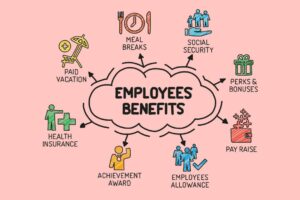In today’s competitive job market, companies are constantly looking for ways to attract and retain top talent. One of the key ways they do this is by offering a comprehensive benefits package. A company benefits package is a set of perks and programs that an employer provides to their employees in addition to their salary. In this blog post, we will explore the different types of benefits that companies commonly offer, as well as how to start planning them.
Contents
What Are The Company Benefits Package?
A company benefits package is a collection of non-wage compensation provided to employees by an employer. A company’s benefits package is an important part of an organization’s overall compensation strategy and can have a significant impact on employee morale, loyalty, and productivity. The specific benefits offered may vary depending on the company, industry, and employee position, and may be subject to legal requirements or regulations.
Examples Of Compulsory Company Benefits Packages

Here are some examples of compulsory company benefits packages in different countries:
- Health/Medical Insurance: Many countries require employers to provide health or medical insurance to their employees. This can include coverage for doctor visits, hospitalization, prescription drugs, and other medical expenses.
- Unemployment Insurance: In some countries, employers contribute to a government-run unemployment insurance program that provides financial support to employees who lose their jobs.
- Employee’s Provident Fund (EPF): This is a retirement savings scheme that is mandatory for employers to contribute to in some countries. It requires employers to deduct a portion of an employee’s salary each month and deposit it into a savings account that can be withdrawn when the employee retires or leaves the company.
- Workplace Security: In many countries, employers are required to provide a safe and secure working environment for their employees. This can include measures such as fire safety, evacuation procedures, and workplace violence prevention.
These are just a few examples of compulsory company benefits package that may be required by law in different countries.
Additional Best Employee Benefits Program
Those are all great examples of employee benefits programs! Here are some additional benefits programs that employers may consider offering to their employees:
- Employee Assistance Programs (EAPs): EAPs provide employees with confidential counseling and support services to help them deal with personal or work-related problems, such as stress, anxiety, or addiction.
- Tuition Reimbursement: Employers can offer tuition reimbursement programs to help employees pay for continuing education or job-related training.
- Retirement Planning: Employers can offer retirement planning services, such as financial counseling or investment advice, to help employees prepare for their future.
- Employee Discounts: Employers can negotiate discounts with local businesses and vendors to offer to their employees, which can help employees save money on things like groceries, travel, and entertainment.
- Employee Referral Programs: Employers can offer incentives to employees who refer qualified candidates for open positions, which can help the company attract and retain top talent.
- Commuter Benefits: Employers can provide commuter benefits, such as transit passes or parking subsidies, to help employees save money on their daily commutes.
- Diversity and Inclusion Programs: Employers can offer training and support programs to promote diversity and inclusion in the workplace, which can help create a more welcoming and productive work environment.
These are just a few examples of employee benefits programs that can help employers attract and retain talented employees, improve employee morale and productivity, and create a positive workplace culture.
Why Does Employer Offer The Benefits Package To Employees?
Employers offer benefits packages to employees for a variety of reasons, including:
- Attracting and retaining employees: By offering competitive benefits packages, employers can attract talented job candidates and retain current employees who may be considering other job opportunities.
- Improving morale and productivity: Benefits packages can help employees feel valued and appreciated, which can lead to increased job satisfaction and productivity.
- Meeting legal requirements: In many countries, employers are required by law to offer certain benefits to their employees, such as health insurance, retirement plans, and workers’ compensation insurance.
- Demonstrating corporate social responsibility: Offering benefits packages that support employee wellness, education, and work-life balance can help demonstrate a company’s commitment to social responsibility and sustainability.
- Reducing costs associated with a turnover: By offering benefits packages that support employee well-being and job satisfaction, employers can reduce the costs associated with turnover, such as recruiting, hiring, and training new employees.
Overall, offering benefits packages to employees is an investment in the company’s workforce and can help create a positive workplace culture that benefits both employees and the organization as a whole.
How To Plan A Benefits Package For Employees?

Planning a benefits package for employees involves several steps, including:
- Identify the needs of your employees: Start by understanding the needs and preferences of your employees. Conduct surveys, focus groups, or one-on-one interviews to gather information about what benefits are important to them and what they are currently lacking.
- Determine your budget: Determine how much your company can afford to spend on benefits. Consider the cost of different benefits options, as well as the potential return on investment in terms of employee satisfaction, retention, and productivity.
- Research different benefits options: Research the different benefits options available, including health insurance, retirement plans, paid time off, wellness programs, and other benefits that align with the needs of your employees.
- Evaluate legal requirements: Review the legal requirements for benefits in your country or region to ensure that you are meeting all of the necessary obligations.
- Consider the administrative requirements: Consider the administrative requirements of each benefit option, including the time and resources required to manage each benefit program.
- Develop a comprehensive benefits package: Once you have identified the benefits that are important to your employees and that align with your budget and administrative capacity, develop a comprehensive benefits package that includes all of the relevant benefits. Be sure to communicate the benefits package clearly to employees and provide support and guidance for employees who need help navigating the various benefits options.
- Monitor and adjust the benefits package as needed: Regularly monitor the effectiveness of your benefits package and make adjustments as needed based on employee feedback, changes in legal requirements, or changes in your company’s financial situation.
By following these steps, you can develop a benefits package that meets the needs of your employees while also aligning with your company’s budget and goals.
Conclusion
In conclusion, offering a comprehensive benefits package to employees is an important investment for employers. A well-designed benefits package can attract and retain talented employees, improve morale and productivity, and demonstrate a commitment to social responsibility. By following these steps, employers can create a benefits package that supports their employees’ well-being and contributes to the overall success of the organization.
Employee wellness programs are the key to improving employee motivation, productivity, and retention. At MantraCare, we have a team of health experts, counselors, and coaches who serve corporate employees with 10+ wellbeing programs including EAP, Employee Diabetes Reversal, Corporate MSK, Employee Fitness, Corporate Yoga, and Employee meditation.
